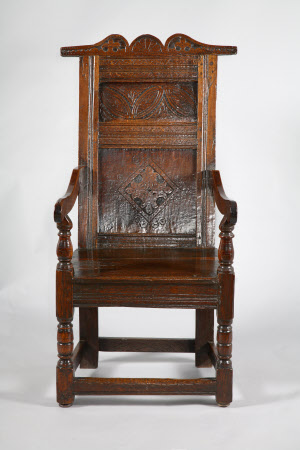Panel-back armchair
Category
Furniture
Date
circa 1630
Materials
Carved, turned and joined oak
Measurements
124 x 65 cm
Place of origin
England
Order this imageCollection
Hardwick Hall, Derbyshire
NT 1128064
Summary
An oak panel-back armchair, England, possibly Yorkshire, late 17th century. This chair has been known since the early 19th century as the chair used by the 4th Earl [& 1st Duke] of Devonshire (1640 - 1707) in 1688, whilst plotting with other noblemen at the Cock and Pynot Inn, also known as 'Revolution House', to depose James II in favor of William of Orange. The chair (then still at the Inn) was illustrated in 'The Mirror of Literature, Amusement and Instruction' of October 1841. It seems little changed. The - possibly associated - cresting of three lobes, above a small upper panel and a larger panel carved with a lozenge in low relief, the uprights and rails moulded. The downswept arms on baluster and ring-turned supports. The legs of parallel baluster form. -- Much of the 16th and 17th century oak at Hardwick Hall, the indigenous pieces aside, was probably purchased by the 6th Duke in the 19th century to enhance the Elizabethan feel of the property, much as his contemporary, Charles Winn of Nostell Priory, is known to have done (Westgarth, Raikes). The 6th Duke is recorded, for instance, as having bought 'oak Arm chairs' in 1846.
Provenance
This chair is mentioned in the early and mid-19th century as remaining at the 'Cock and Pynot'. In 1932, Kelly's Directory records that it was by then at Hardwick Hall, so probably purchased in the late 19th/early 20th centuries. By descent until, following the death of Edward William Spencer Cavendish, 10th Duke of Devonshire (1895 - 1950), Hardwick Hall and its contents were accepted by HM Treasury in part payment of death duties and transferred to the National Trust, in 1959.
References
Westgarth 2009, M. Westgarth, 'A Biographical Register of Nineteenth Century Antique and Curiosity Dealers', Regional Furniture XXIII (2009), 1 - 205 Raikes, 2003: S.Raikes. ““A cultivated eye for the antique”: Charles Winn and the enrichment of Nostell Priory in the nineteenth century.” Apollo 157.494 (2003): pp.3-8.
